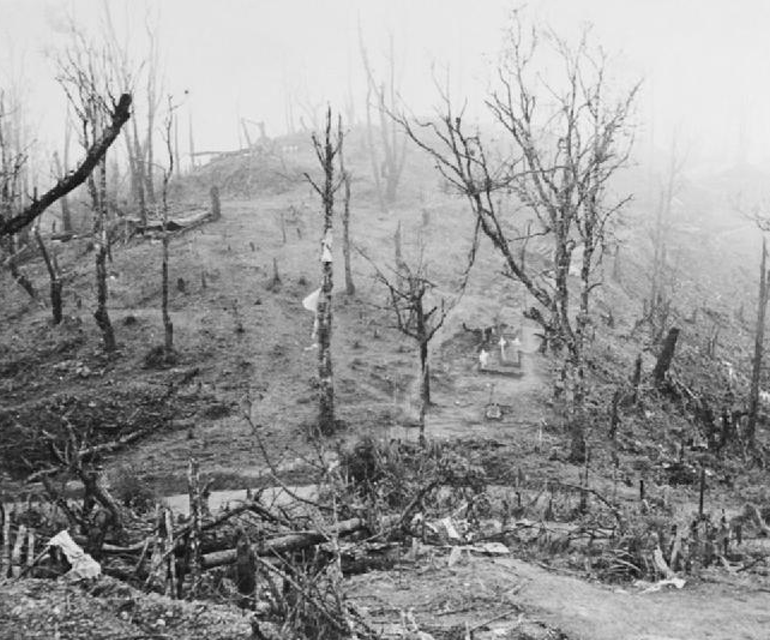Remembering the Battle of Imphal- Kohima

Silvester Phanbuh
On winter afternoons, if one can sneak into the premises of Shillong's famous St.Edmund's school, it is an enjoyable experience. The din and clamour of students are missing and a walk into the courtyard near the stone building reveals a bit of history. Rewind back seven decades, and the din and clamour of the Second great war had taken over. As a stretched Axis force planned to descend from the hills of present day Manipur and Nagaland, Shillong became a center of activity. These very stone walls at St. Edmund's served as an infirmary for Allied soldiers stationed on the South East Asian corridor of the Eastern Front.
Between March and July of 1944, the North Eastern frontiers of India were the scene to some of the most decisive battles in the war that created the world we know. Along with immeasurable death and destruction, modern aviation, mechanics and post colonial development accelerated due to the industrial and political circumstances of the Second World War. The so-called isolated hills of North East India were key to many a strategy that would have changed the face of the whole subcontinent. Yet, these globally important events have been polished over by school textbooks bent on protecting the patriotism of India's independence movement from being diluted with bravery of Allied Indian troops. But the truth takes no sides, for just like the brave-hearts who fought the Raj, there were equally heroic and tragic tales of battles, soldiers and local populations caught in the crossfire, fighting for the British Allied forces as well as the Axis.
Just like Stalingrad signalled a change in the order of the Western Front, Japan's invasion of India was thwarted permanently in the Burma campaign, with Imphal and Kohima setting the stage to the bloodiest battles in history.
The details of the war are now solely a subject mainly historians and aficionados of war history discuss. Such has been the neglect of these incidents, that the current population of the NE know of WW2 as a distant event and probably they will have images of battle-scarred European landscapes from war movies in their heads rather than the smouldering ranges and artillery hit hills of their own backyard.
It was a cruel stage for Indian Allied soldiers, who battled not only the Japanese imperialists, but also their own countrymen, who fought for Subhash Chandra Bose's Indian National Army. One has to empathise with both sides as some fought to free their nation and the others fought to fight off an army capable of cold massacre, as Nanking was witness. While Imphal lay under siege, the body count increased and war's brutal neutrality was the winner as the INA succumbed and the under-resourced Japanese lost a significant amount of troops and supplies. The battle cries of the victors resonated for years as many of the British Indian divisions lived on as part of the new Indian army post 1947.
As Imphal was battered, miles north, the Battle of Kohima was fought. This was a battle that would enter the annals of war history as one of the greatest fought. Author Leslie Edwards would coin this the British Indian Thermopylae, referring to the famous battle between the Spartans and the Persians. While waiting for reinforcements from distant posts, 1500 British, Indian and Gorkha soldiers fought off more than 13,000 Japanese. The then District Commissioner's bungalow and the tennis court was where some of the most intense combat was seen as the Japanese tried to gain control of the ridge on which it was situated. The Allied troops at Kohima held on as reinforcements arrived, and the Japanese fell eventually – away from their supply and without air cover. The local populations of the region played a crucial part by not helping the invading Japanese troops with supplies, the factor that led to their defeat. With Kohima won, Imphal was liberated soon. The battle of Kohima is considered as important as the battles of Stalingrad and El Alamein; however, it never received the kind of attention that the other two conflicts did. Today, the fallen lay still, in the war cemeteries in Imphal and Kohima, the epitaph in the latter cemetery sombre in its reminder that reads, "When you go home tell them of us and say for your tomorrow we gave our today."
One will not understand the war as much as the generation that witnessed it. These battles cannot be summarized as the moves and twists of deadly decisions were more complicated than a good novel. As a region looking for relevance and history, let us first study these years of conflict and understand that in those hills and ridges of bamboo and thick forest, an empire fell and another soon after that. Before we further lose our connection to this world shaking event, let us throng our libraries, search those websites and relive with the last of that generation, those fearful and exciting months when the thunder of war shook the hills. Let not others teach you history, instead discover it yourself.

















